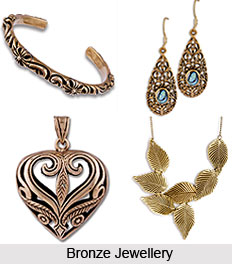 Bronze is an alloy majorly containing copper. It is extensively used in making handicrafts and jewellery. Before copper, gold and silver were the only metals that were being used to carve jewellery. The bronze jewelry exuded the kitschy gold effect while maintaining a reasonable price range. The Bronze Age brought along with it beautiful and exquisite pieces of jewellery that charmed its way through many centuries and eras.
Bronze is an alloy majorly containing copper. It is extensively used in making handicrafts and jewellery. Before copper, gold and silver were the only metals that were being used to carve jewellery. The bronze jewelry exuded the kitschy gold effect while maintaining a reasonable price range. The Bronze Age brought along with it beautiful and exquisite pieces of jewellery that charmed its way through many centuries and eras.
Bronze is typically a mix of copper and tin, and may contain small amounts of lead or arsenic. The ratio of tin to copper is typically between 5 % and 15 %. Bronze is a somewhat generic term that refers to a broad range of copper alloys. Although both copper and tin naturally occur, the two ores are rarely found together.
During the Bronze Age most women wore earrings, neck-pieces and other ornaments made out of bronze. The jewellery highlighted the bronze era along with the growing love for this metal among women. Bronze has long been used in jewelleries like bangles, earrings etc. Bronze is ideal for casting art works; it flows into all crevices of a mould, thus perfectly reproducing every detail of the most delicately modelled jewellery pieces. Bronze jewellery was made in much the same way as Silver jewellery was, as the two metals have similar working properties.
Origin of Bronze Jewellery
When the Bronze Age was established, it definitely became a highly appreciated metal among people of that Age. It"s no wonder that during that era, bronze became a desirable metal for jewellery also. Most jewellery during that time was a work of craft that produced artisan jewellery designs.
The period, during which the Bronze Age came into existence, the bronze was introduced during the Mesopotamian Era. It was simultaneously introduced to India around the same time.

Bronze is definitely one of the oldest and classiest metals for jewellery available in India. If one goes by the historical evidence and artifacts, one can see that most of the beautiful and exquisite pieces of jewellery were made out of bronze. The sensuality of the copper color made bronze a beautiful, timeless and exquisite source of art and craft, which still prevails in India.
Innovations of Bronze Jewellery
Bronze as a metal has gone through various innovations. The exquisite pieces of jewellery showcase traditional and royal appeal, especially the kind that has an ethnic and Indian touch. The most common and popular forms of Bronze jewelry these days are big chunky bangles, over sized rings, heavy pendants that hang off thick bronze chains and funky looking neck pieces as well. Bronze is a type of metal that complements all skin tones and looks fabulous on all kinds of people regardless of their attire. It is also the type of jewellery which looks ornate, stylish and classy, while at the same time simple and elegant.
Bronze jewellery looks spectacular when worn with long Kurtas, Khadi Jackets, linen tops or with chic looking cotton sarees. One does not really need an occasion for bronze jewellery, as it can fit easily into any type of occasion or ambience.
Instructions for Cleaning Bronze Jewellery
•Wipe the bronze jewellery with a silver polish cloth.
•Apply some mild soap onto the bronze jewellery and rub it.
•Hold the jewellery under running water to rinse the soap off.
•Gently wipe the water off of the bronze jewellery and dry it using a clean towel.









